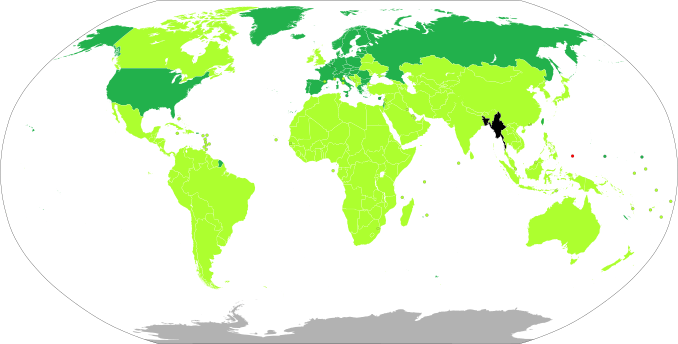 |
|---|
All visitors to Palau may generally obtain a visa on arrival, unless they are a citizen of one of the visa-exempt countries or a citizen of a country whose nationals must obtain a visa in advance.
Visa policy map[edit]

Entry requirements[edit]
All visitors arriving in Palau must have a valid passport (valid for at least 6 months) and proof of return arrangements.[1]
Palau pledge[edit]
All visitors are required to sign the Palau Pledge in front of the immigration officer at the port of entry in order to enter Palau.[2]
Visa exemption[edit]
Citizens of the following countries can enter Palau without a visa, for stays up to the duration listed below:[1][3]
|
1 year 90 days
30 days |
Visa-free agreements[edit]
 European Union - Palau signed a mutual visa-waiver agreement with the European Union on 7 December 2015. This agreement allows all citizens of states that are contracting parties to the Schengen Agreement to stay without a visa for a maximum period of 90 days in any 180-day period.
European Union - Palau signed a mutual visa-waiver agreement with the European Union on 7 December 2015. This agreement allows all citizens of states that are contracting parties to the Schengen Agreement to stay without a visa for a maximum period of 90 days in any 180-day period. Taiwan - Palau signed a mutual visa-waiver agreement with the Taiwan on 25 October 2018 which entered into force on 1 December 2018. This agreement allows citizens of Taiwan to stay without a visa for a period of 90 days.[4]
Taiwan - Palau signed a mutual visa-waiver agreement with the Taiwan on 25 October 2018 which entered into force on 1 December 2018. This agreement allows citizens of Taiwan to stay without a visa for a period of 90 days.[4] Russia - Palau signed a mutual visa-waiver agreement with the Russia on 28 September 2018 which entered into force on 27 December 2018. This agreement allows citizens of Russia to stay without a visa for a period of 30 days.[5]
Russia - Palau signed a mutual visa-waiver agreement with the Russia on 28 September 2018 which entered into force on 27 December 2018. This agreement allows citizens of Russia to stay without a visa for a period of 30 days.[5]
Visa on arrival[edit]
Nationals of any country, except Myanmar and Bangladesh, can obtain a visa on arrival.
The visa is valid for a maximum stay of 30 days but can be extended twice for a fee. In order to obtain a visa on arrival visitors are required to hold a proof of sufficient funds (200 USD per week).[1][6]
Visa in advance[edit]
Prior visas are required for nationals of the following countries:[1]
See also[edit]
References[edit]
- ^ a b c d "Visa and passport". Timatic. International Air Transport Association through Emirates. Retrieved 1 April 2017.
- ^ "Palau Pledge". PALAUPLEDGE.COM. Retrieved 2024-01-26.
- ^ "Agreement".
- ^ "Visa waiver between Taiwan and Palau to start from Dec. 1st, 2018".
- ^ "Соглашение между Правительством Российской Федерации и Правительством Республики Палау о взаимной отмене визовых требований для граждан Российской Федерации и граждан Республики Палау". mid.ru (in Russian). Retrieved 10 October 2018.
- ^ "30-days Tourist Visa will be issued upon arrival".


Well, that’s interesting to know that Psilotum nudum are known as whisk ferns. Psilotum nudum is the commoner species of the two. While the P. flaccidum is a rare species and is found in the tropical islands. Both the species are usually epiphytic in habit and grow upon tree ferns. These species may also be terrestrial and grow in humus or in the crevices of the rocks.
View the detailed Guide of Psilotum nudum: Detailed Study Of Psilotum Nudum (Whisk Fern), Classification, Anatomy, Reproduction